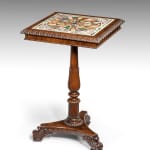George IV Rosewood Table with Italian Specimen Marble Top
ENGLAND & ITALY, circa 1820
75 x 48 x 48 cm
Further images
-
(View a larger image of thumbnail 1
)

-
(View a larger image of thumbnail 2
)

-
(View a larger image of thumbnail 3
)

-
(View a larger image of thumbnail 4
)

-
(View a larger image of thumbnail 5
)

-
(View a larger image of thumbnail 6
)

-
(View a larger image of thumbnail 7
)

-
(View a larger image of thumbnail 8
)

-
(View a larger image of thumbnail 9
)

-
(View a larger image of thumbnail 10
)

-
(View a larger image of thumbnail 11
)

-
(View a larger image of thumbnail 12
)

Provenance
Probably Robert Berkeley (1764-1845) who is likely to have acquired the specimen marble top in Italy between 23 July 1816 and 1818, during his extensive two-year Grand Tour with his two children, Robert and Eliza. Robert had begun building the Palladian style Spetchley Park in Worcestershire in 1811. The house was completed in 1821. During their Grand Tour the family travelled extensively in Italy, visiting various cities in Italy from October 1816 including Florence, Milan, Siena and Rome. During this time they acquired objects for their new home, including possibly the Siena marble.Literature
Spetchley Inventory, 1893, ‘A Rosewood square table marble top (inlaid coloured marbles)’ in the Library.Spetchley Inventory, 1949, ‘A George 4th, rosewood table with square top inlaid central marble panel’ in the Study.
A documentary example of Regency furniture: an exceptional slab of Italian specimen marble inlay incorporating rare and varied antique marbles, mounted on a “custom-made” English base, which incorporates design features which in turn pay homage to the classical origins of the marble top. From the gadrooned edge around the top, through the fluted column and the scroll feet; they all have their origins in classical design. The incredibly crisp carving of the fashionably exotic imported rosewood echoing the precision of the hand cut and polished marbles.
The square top inset with a panel radially inlaid with stone specimens including lapis, porphyry, malachite, jasper and granite. Supported on a shaped column decorated with carved leaf forms. Terminating in a tri-form base with concealed brass castors.
The top acquired in Italy on Grand Tour by Robert Berkeley 1816-18, the table made in England on his return.
Gillows produced two tables to support ‘Grand Tour’ inlaid specimen tops for Stephen Tempest of Broughton Hall, North Yorkshire. Susan E. Stuart comments that: ‘Like so many gentlemen in the eighteenth and early nineteenth centuries, Stephen Tempest and his family visited Italy. They returned with two Italian marble pieces as mementoes of their visit’ (Susan E. Stuart, ‘Gillows of Lancaster and London, 1730-1840: Volume I’ (Antique Collectors’ Club, 2008), p.338). Made at Gillows’ Oxford Street premises in 1821, Stuart includes a quote taken from a letter written by Gillows to Tempest: ‘A handsome pillar and claw [table] for your marble slab, richly carved in rosewood’ (ibid, p.337). She also illustrates this table in ‘Gillows of Lancaster and London, 1730-1840: Volume I’ (Antique Collectors’ Club, 2008), p.337, plate 391. The table is recorded as having cost ‘£47.0.0d’ and Stuart comments that the carving would have accounted for a great deal of the cost, but also that rosewood itself was an expensive wood. She observes that: ‘the Broughton invoice demonstrates that similar pillar and claw tables were made by Gillow & Co. of Oxford Street at a much earlier date, that is by the early 1820s’ (ibid, p.338).
In the first quarter of the 19th Century Robert acquired mahogany furniture for his new house from the leading cabinet-makers of the time, including Gillows, ordering seat furniture as well as table frames to house his hardstones. The Gillows’ ‘Estimate Sketchbook’ shows that the company delivered some mahogany furniture to Robert Berkeley Esq., Spetchley, on 10th November 1824.
Gillows of Lancaster and London: Robert Gillow (1704–1772) was an English furniture manufacturer, who started out as an apprentice joiner in c.1718 before founding the luxury furniture and furnishings firm ‘Gillow of Lancaster’ in 1730. The firm also had a London workshop in Thames Street, and rapidly established a reputation for supplying high quality furniture and furnishings to the richest families in the country. In 1764, a permanent London branch of Gillows was established at 176 Oxford Road, now Oxford Street, by Robert’s son, Thomas Robert Gillow (1745–1793), and William Taylor, the studios in which these drawings were made. Following Robert’s retirement in 1769, the business was continued by two of his sons: Richard (1734–1811) and Thomas Robert. For over a century, the firm was known for its luxury furniture and furnishings.












